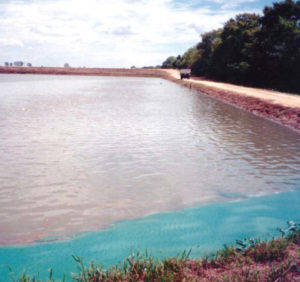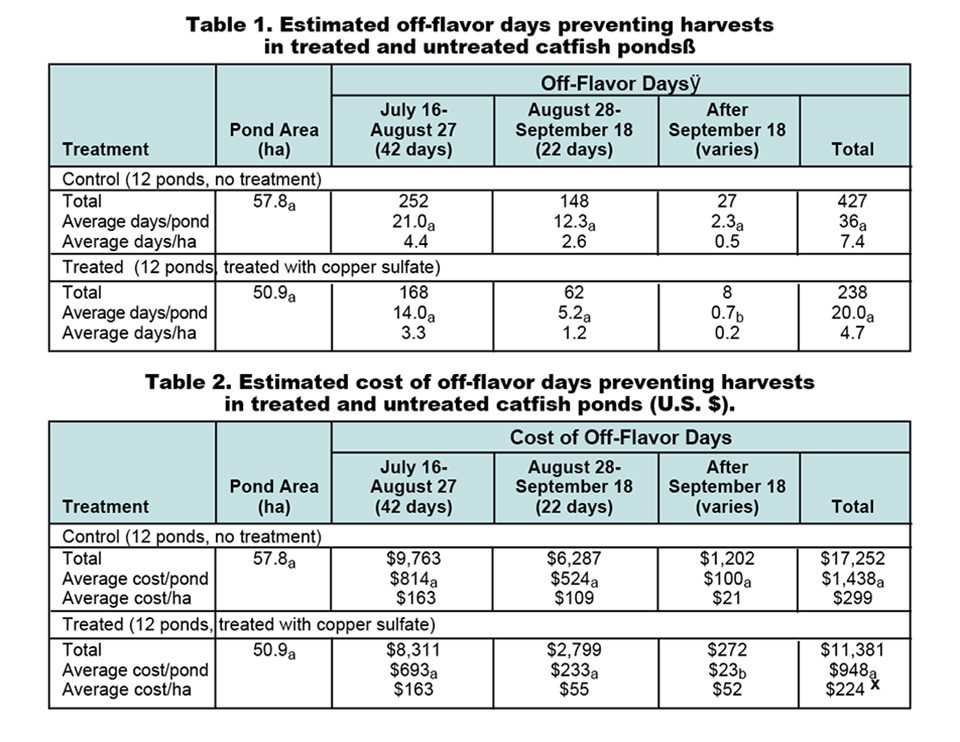Weekly low-dose applications appear to be beneficial

In the competitive cultured seafood world, “off-flavor” fish can result in consumer dissatisfaction and reduced consumption of a particular seafood product. In the United States farm-raised catfish industry, off-flavor management is taken very seriously because of the need to maintain a high-quality, excellent-tasting product for consumers and corresponding economic implications for processing and production.
For producers, off-flavors can delay farm-raised catfish harvests and result in additional feed costs, interruption of cash flow, and potential catfish loss from disease, possible water quality deterioration, and bird predation during the extended holding period. Additionally, uncertainty about the supply of “on-flavor” catfish during the summer and autumn months when most off-flavor episodes occur can keep processing plants from operating at optimal levels.
U.S. catfish producers’ economic losses from off-flavor have been estimated as high as U.S. $47 million annually. In 2001, the main author estimated the cost of off-flavor harvest delays at $8.85 per hectare per day. Various studies have estimated the additional costs of production due to such delays can range $0.01 to 0.25 per kilogram catfish produced. Considering the typical U.S. catfish production cost is approximately $1.43 per kilogram, the additional costs caused by off-flavor could reflect 3-17 percent of total production costs.
Copper sulfate management
The off-flavors of the greatest concern to the catfish industry are those characterized as “musty” or “earthy,” which are produced by certain species of cyanobacteria that grow in catfish ponds. One management approach for controlling musty off-flavor in pond-raised catfish is the application of copper sulfate to reduce the abundance of the cyanobacterium (Oscillatoria perornata). The musty odor is due to the production of 2-methylisoborneol (MIB) by O. perornata.
The main disadvantage of copper sulfate treatment is that the amount of free copper can be affected by water quality variables. Large-scale treatments can become ineffective or increase copper toxicity to levels that kill or stress the catfish or nontargeted green algae. An alternative approach using low doses of copper sulfate applied weekly was tested to evaluate its control of off-flavor cyanobacteria.
U.S. studies
In experiments at the National Warmwater Aquaculture Center in Stoneville, Mississippi, USA, low doses of copper sulfate had a positive effect on catfish flavor quality and provided increased net returns to producers. A second study was conducted to evaluate the effectiveness of weekly copper sulfate applications on the prevalence of off-flavor in catfish on commercial farms.
The large size of commercial ponds can make rapid and thorough dispersal of copper sulfate difficult and thus hinder the effectiveness of the treatment. Rapid dispersal is necessary so that copper contacts and is taken up by the O. perornata cells. With slow dispersal, the copper sulfate can rapidly disappear from the water column and end up in the pond sediments, bound and unavailable for use as an algaecide.
While the first study (Tucker et al., 2001) was a controlled experiment using 0.4-hectare ponds, the more recent study was conducted in 3- to 6-hectare ponds on two catfish farms in western Mississippi. Farm managers applied 0.5 mg copper sulfate pentahydrate per liter weekly beginning in the late spring and continued until the water temperature dropped below 20 degrees-C.
Water samples were collected from treated and untreated ponds approximately every three weeks and monitored for levels of MIB, chlorophyll alpha, and phytoplankton community structure and abundance. In addition, catfish from each study pond were checked for off-flavor during the third year of the study.
Results
Levels of MIB and the abundance of O. perornata were significantly reduced in the treated ponds at one farm, while the numbers of green algae and diatoms, the preferred type of phytoplankton in catfish ponds, increased significantly at both farms. The overall prevalence of all types of off-flavor was reduced by 50 percent. Thus, weekly low-dose applications of copper sulfate appeared to be beneficial in mitigating musty off-flavor problems in commercially produced catfish.
The cost of applying crystalline copper sulfate during the mid-July through mid-September period was estimated at U.S. $7.09 per application per hectare. Based on the collected farm data, the number of estimated off-flavor delay days for each pond treatment became the basis for quantifying additional operating costs during the extended harvest delay periods.
Fish sampling results were used to hypothetically determine if fish in a particular pond could be harvested. A “counting” methodology was developed in which the count of off-flavor days began with the detection of off-flavor and lasted until the next off-flavor testing occurred. Resulting harvest delays were summed over three sampling dates and used in estimating periodic and overall costs.
Off-flavor harvest delays totaled 427 days for the 12 untreated ponds and 238 days for 12 treated ponds, but were not statistically different (Table 1) due to the large variation among ponds and the small sample size. There was one significant difference between the number of off-flavor days in the treated ponds between the second and third sampling dates. Overall, the estimated costs incurred during the off-flavor harvest delay periods were estimated as U.S. $17,252 for the untreated ponds and $11,381 for the treated ponds (Table 2).

Note: Cited references are available from the first author.
(Editor’s Note: This article was originally published in the February 2006 print edition of the Global Aquaculture Advocate.)
Now that you've finished reading the article ...
… we hope you’ll consider supporting our mission to document the evolution of the global aquaculture industry and share our vast network of contributors’ expansive knowledge every week.
By becoming a Global Seafood Alliance member, you’re ensuring that all of the pre-competitive work we do through member benefits, resources and events can continue. Individual membership costs just $50 a year. GSA individual and corporate members receive complimentary access to a series of GOAL virtual events beginning in April. Join now.
Not a GSA member? Join us.
Authors
-

Terrill R. Hanson, Ph.D.
Department of Agricultural Economics
Mississippi State University
Mississippi State, Mississippi 39762 USA -
Kevin K. Schrader, Ph.D.
USDA – Agricultural Research Service
Natural Products Utilization Research Unit
National Center for Natural Products Research
University, Mississippi, USA
Tagged With
Related Posts

Health & Welfare
Antigens provide immunity against ich in channel catfish trials
Vaccination against the Ich parasite is an alternative to chemical treatment. Fish develop a humoral immune response to trophont antigens, with the degree of protection related to the immunizing doses of trophonts used.

Health & Welfare
A look at tilapia aquaculture in Ghana
Aquaculture in Ghana has overcome its historic fits and starts and is helping to narrow the gap between domestic seafood production and consumption. Production is based on Nile tilapia.

Innovation & Investment
Assessing coloration in channel catfish fillets
Because consumers look at color to gauge quality of catfish fillets, the authors developed a digital photography measurement method to assess yellowness.

Health & Welfare
CART regulates food intake in channel catfish
Experiments by the authors showed that the gene activity of the brain neurotransmitter CART changed in catfish in response to feed intake.


